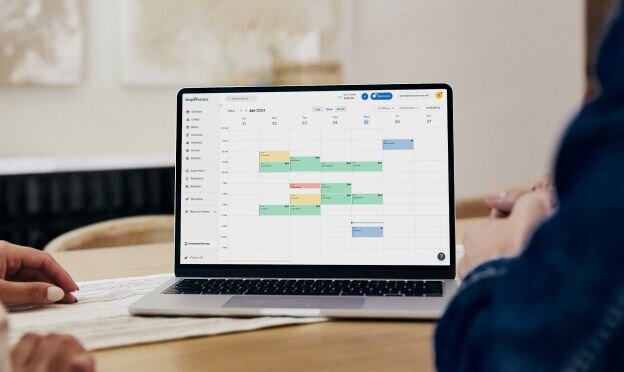Core Beliefs Worksheets
Download the free core beliefs worksheet
Download free resource
Enter your email below to access this resource.
By entering your email address, you are opting-in to receive emails from SimplePractice on its various products, solutions, and/or offerings. Unsubscribe anytime.

If you’re looking for core beliefs worksheets, you can download and use this free core beliefs worksheet PDF with your clients.
As a mental health clinician, you’ll use a range of tools and interventions suited to the challenges your clients are facing. These might include working on cognitive distortions using cognitive behavioral therapy (CBT) or using the wise mind tool from dialectical behavioral therapy (DBT).
The free core beliefs worksheet in this article includes core beliefs and values examples, which expand on CBT interventions for both kids and adults.
If you’re practicing CBT with your clients, download our free core beliefs worksheets PDF to save to your electronic health record (EHR)—you can also print it to use in session or share it electronically as homework.
What are core beliefs?
In 1979, the founder of cognitive behavioral therapy, Aaron Beck, MD, published a book that outlined the basic tenets of CBT. Namely that, in every situation, we have an automatic thought that influences our feelings and behavior.
These situations shape our core beliefs (also called schemas or “doubt labels”), how we process and interpret information, and our overall judgments/appraisals of ourselves, others, and the world.
Core beliefs can be difficult to shift because they are rigid, inflexible, and strongly held. It’s important to understand core beliefs because, when negative, they can play an important role in maintaining symptoms of anxiety, depression, and psychosis.
Here’s an example of automatic thoughts and negative core beliefs:
Sara heard from her colleague that they are attending another co-worker’s party this weekend, but she hasn’t received an invitation.
Sara’s automatic thoughts: I am the only person in the office who wasn’t invited. They must not like me.
Negative core belief: I am unlikeable.
Core beliefs are often rooted in early childhood experiences and reinforced through life experiences. For example, the child of a parent with a mental health condition grows up to think they are unlovable because they were neglected at home. They may continue to reinforce this belief by choosing neglectful and emotionally unavailable partners.
Additionally, core beliefs can occur as a result of traumatic experiences. For example, consider a situation of a female chief executive officer (CEO) who is, in reality, a strong and commanding person, however, after surviving a sexual assault, she may develop a core belief of being weak and vulnerable.
How to identify negative core beliefs
Some key ways to identify negative core beliefs with clients include:
Use a negative core belief worksheet
Use core beliefs worksheets to help clients identify their negative automatic thoughts and the core beliefs that they stem from.
Ask your client to review and circle a list of names they might call themselves using a list of core beliefs CBT PDF.
Words and phrases that may be included are: unlikeable, unlovable, unworthy, incompetent, uncool, awkward, undesirable, fat, bad, lazy, stupid, unwanted, unattractive, ugly, loner, ineffective, useless, demanding, boring, outcast, not good enough, a failure, loser, inferior, a fraud, disgusting, insignificant, etc.
Identify the automatic thought
During the therapeutic process, your client may describe past life experiences that cause them distress.
Ask them about any vivid memories or triggers, and to identify any negative ideas they formed about the event.
This may illustrate a core belief, or you may have to dig further by asking if any life events contributed to their interpretation of the situation.
Spot ineffective compensatory strategies
If it is challenging for clients to identify their core beliefs, you might want to start looking at certain behaviors, such as substance use, non-suicidal self-injurious behaviors, avoidance, passivity, or overly controlling behavior.
These behaviors may be influenced by conditional rules or assumptions that stem from core beliefs.
For example, if one of your client’s core beliefs is thinking they are incompetent, they may create a conditional rule to stay late at work every day to ensure they complete their tasks ahead of time, so that their boss will think they are competent.
Core beliefs worksheet for kids
When working with children and adolescents, you can use a worksheet with simplified words and phrases.
Ask the client to circle or talk about which labels they identify with, such as:
- The teacher doesn’t like me
- I’m not good enough
- I’m stupid
- I don’t have any friends
Core beliefs and values examples
Below are some common core beliefs you may hear in sessions that relate to how clients see themselves, others, and the world around them.
Self core beliefs
- I am worthless
- I am vulnerable
- I am unlovable
- I am all alone
- I’m a failure
- I am helpless
- I’m terrible at X
- I’m incompetent
- I’m ineffective
- I’m powerless
- I’m toxic
- I don’t deserve to live
Core beliefs of others
- Everyone always abandons me
- Everyone thinks I’m a burden
- No one wants to be my friend
- All men are unsafe
- People think I’m weird
Negative core beliefs about the world
- The world isn’t safe
- Going outside is scary
- The world is doomed
How to use the core beliefs worksheet
You can use the core beliefs worksheet in individual sessions with clients, group sessions, or as homework for clients to fill out on their own.
You may provide the client with a list of core beliefs to choose from during the session, like the list of negative core beliefs above.
Once you have helped the client identify some of their core beliefs, you can move on to look at their intermediate beliefs (assumptions, attitudes, or rules) that stem from the core belief.
Then, you can use the core beliefs worksheets PDF to help them challenge and reframe their core beliefs and assumptions to improve their mood, behavior, and overall view of the world.
How SimplePractice streamlines running your practice
SimplePractice is HIPAA-compliant practice management software with everything you need to run your practice built into the platform—from booking and scheduling to insurance and client billing.
If you’ve been considering switching to an EHR system, SimplePractice empowers you to streamline appointment bookings, reminders, and rescheduling and simplify the billing and coding process—so you get more time for the things that matter most to you.
Try SimplePractice free for 30 days. No credit card required.

